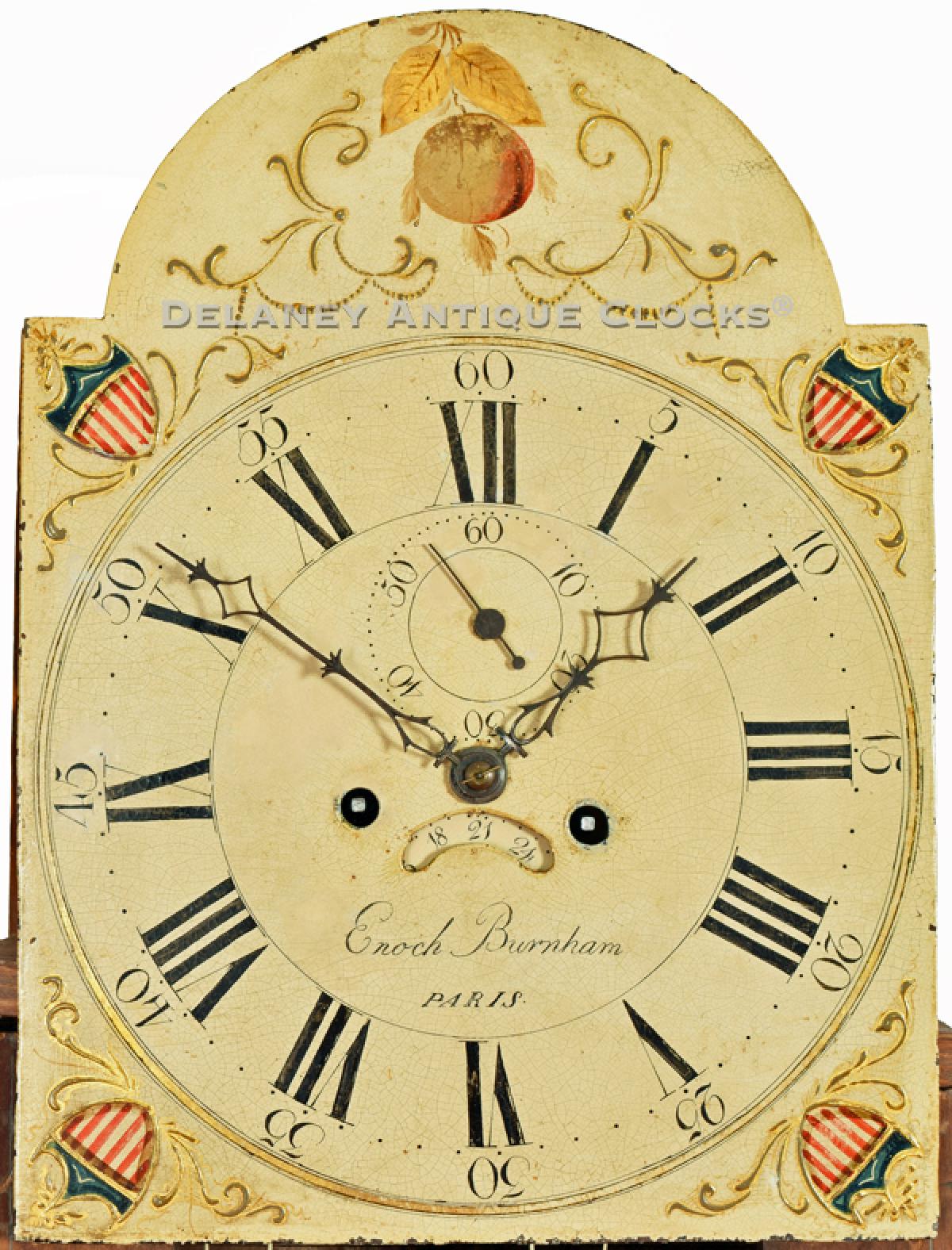Enoch Burnham of Paris, Maine. A cross-banded mixed woods case tall clock in a mahoganized finish. UU-19.
This fine example exhibits a traditional case form that was very popular in Augusta, Maine. The case is constructed in a number of indigenous woods that include birch, maple, bird's-eye maple, and white pine. A mahogany veneer is used as an accent wood. The primary woods are treated in a brown wash that adds consistency to the natural coloring. This treatment is most likely original to this example and is in excellent condition. Staining cases of country clocks was a common practice. This fine example stands on cut-out bracket feet. They have good height and transition into a drop apron below the base section. The lower molding is a simple design and is applied to three sides of the base section. A rectangular-shaped door is fitted into the waist section. It is framed with applied molding. This molding is finely reeded. The door panel is framed in a mahogany cross-banded border. The central panel features a selection of bird's-eye maple veneer. This is a very decorative selection of wood. Quarter columns are set into the waist's corners and decorated with ring turnings. These terminate in brass quarter capitals. The bonnet features a pierced and open fretwork style pattern. This is a traditional Augusta pattern. The three finial plinths are surmounted with brass ball and spike finials. The bonnet columns are turned and end in brass capitals. They flank the arched bonnet door, which is fitted with glass and opens to a colorfully painted dial of Boston origin.
This dial is of Boston manufacture. It is an iron dial that is attached directly to the movement without a false plate. It was most likely painted by the Willard & Nolen firm of Boston circa 1805. It is skillfully decorated, featuring traditional themes for this period. The four spandrel areas are decorated with American shields. Fanciful gesso and gilt designs frame these details. A golden delicious apple is painted in the arch. Additional gilt swags complement the design. This dial is signed by the clockmaker below the calendar aperture. It reads, "Enoch Burnham / PARIS." The time track is displayed in a traditional format. The hours are scheduled with Roman numerals. The five-minute markers are indicated in Arabic numerals. This dial also shows the seconds on a subsidiary dial and the date of the month in an aperture located below the center arbor.
The movement is brass, eight-day duration, and is of good quality. It is weight driven and features a rack and snail strike system and a recoil escapement. The original tin can weights are still with this clock. The pendulum features a brass-faced bob.
This case measures 89.5 inches or 7 feet 4.5 inches tall to the top of the center brass finial. It is 21 inches wide and 9.5 inches deep at the upper hood molding. This fine example was made circa 1805.
Inventory number UU-19.
It is not known where Enoch Burnham was born. It appears he was born in the Paris area sometime around 1770. Paris is a town that is located approximately 50 miles northwest of Portland in Oxford County. It is the county seat. It is a charming village having wonderful views of Mt. Chocorua and Mt. Washington in the White Mountains. Excellent pastures and orchards have thrived in this region. The Little Androscoggin River provided water power for this region. Burnham was well-established as a clockmaker in Paris prior to 1800. Jonathan Bemis is listed as one of his apprentices who also worked there. It is recorded that Burnham owned a considerable amount of land in this small farming community. He is recorded as living in Westbrook in the 1820s until his death sometime before 1850.
Very few clocks by Burnham are known. Most of the tall case clocks reported are signed on the dial. The place location usually listed is Paris. A Westbrook example is known. For a more complete listing of these Makers, please review "Clockmakers & Clockmaking in Maine 1770 - 1900," written by Joseph R. Katra Jr.














